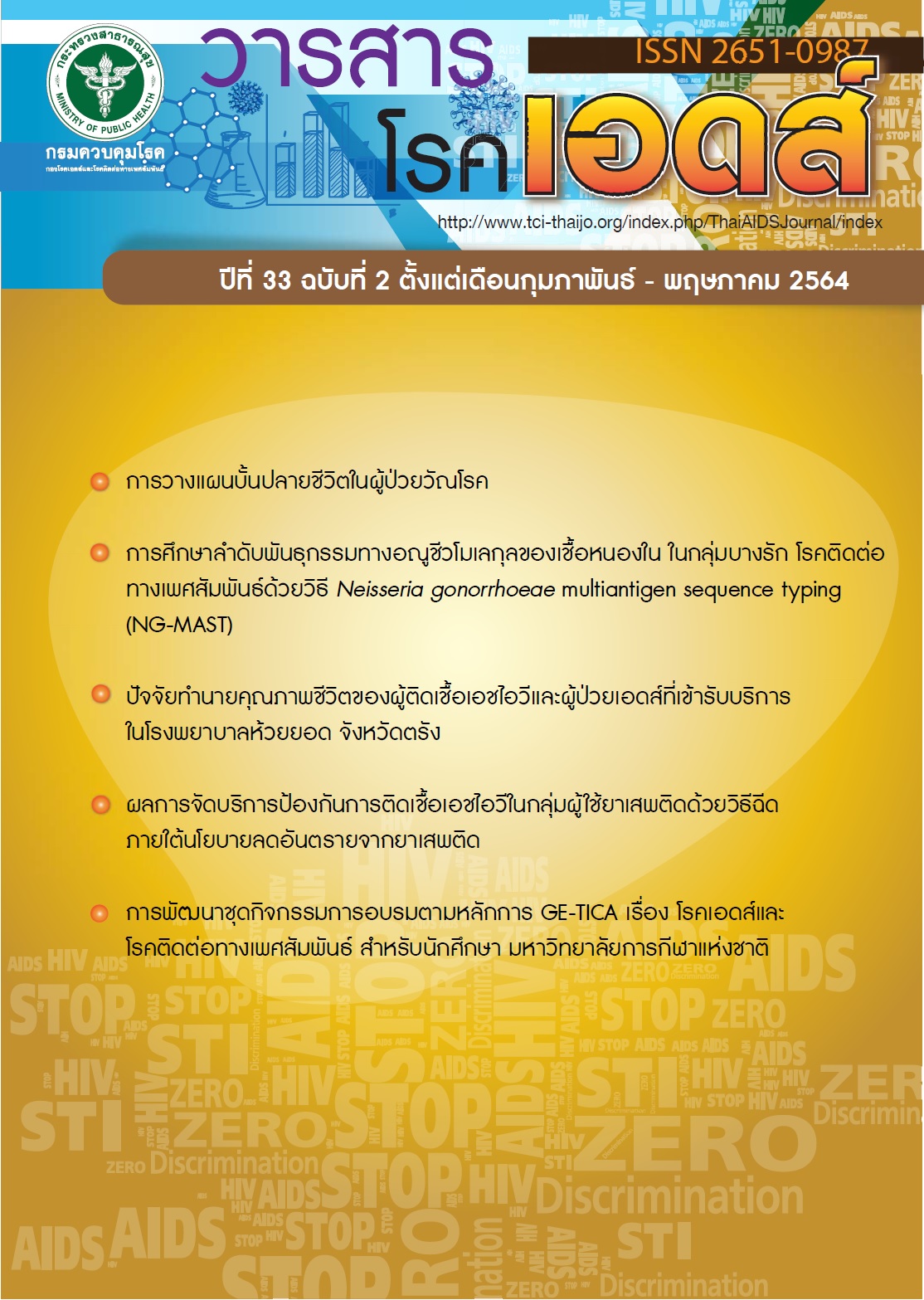การศึกษาลำดับพันธุกรรมทางอณูชีวโมเลกุลของเชื้อหนองใน ในกลุ่มบางรักโรคติดต่อทางเพศสัมพันธ์ด้วยวิธี Neisseria gonorrhoeae multiantigen sequence typing (NG-MAST)
DOI:
https://doi.org/10.14456/taj.2021.5คำสำคัญ:
การศึกษาความหลากหลายของแอนติเจนทางพันธุกรรมของเชื้อนองใน, ลำดับสารพันธุกรรมบทคัดย่อ
โรคหนองในมีสาเหตุมาจากเชื้อแบคทีเรียที่ชื่อว่า “Neisseria gonorrhoeae” ซึ่งเป็น 1 ใน 5 ของโรคติดต่อทางเพศสัมพันธ์ที่พบมากและจัดเป็นปัญหาสำคัญในหลายประเทศทั่วโลก จากรายงานของ WHO ปี 2018 พบผู้ป่วยรายใหม่ในประเทศสหรัฐอเมริกา จำนวน 870,000 รายต่อปี เพิ่มขึ้นจากปี 2015 ร้อยละ 5.70 ในประเทศไทย มีการรายงานพบโรคหนองในมีแนวโน้มเพิ่มสูงขึ้น เริ่มมีการรักษาโรคหนองในโดยใช้ยาปฏิชีวนะตั้งแต่ปี 1935 ปัจจุบันใช้ยาในกลุ่ม 3rd generation Cephalosporin แต่ก็มีแนวโน้มความไวของยาในกลุ่มนี้ลดลง การศึกษานี้ได้รับความอนุเคราะหเ์ ชื้อจากกองโรคเอดส์และโรคติดต่อทางเพศสัมพันธ์โดยใช้ตัวอย่างที่เหลือจากการทดสอบที่อยู่ในช่วง เดือนตุลาคม ถึง พฤศจิกายน พ.ศ. 2559 จำนวน 98 ตัวอย่าง ทดสอบความไวของยาปฏิชีวนะ และตรวจสอบลำดับพันธุกรรม (Sequence type: ST) ด้วยวิธี Neisseria gonorrhoeae multiantigen sequence typing (NG-MAST) จากการทดลองพบว่ายา Ciprofloxacin, Tetracycline และ Penicillin มีค่าความไวของยาลดลงไปจนถึงดื้อต่อยาปฏิชีวนะ ส่วนยา Azithromycin, Cefixime และ Ceftriaxone พบว่ายังไม่มีการดื้อยา แต่พบ 1 ตัวอย่างที่มีแนวโน้มค่าความไวต่อยาปฏิชีวนะลดลงทั้ง 3 ชนิด ผลทดสอบ NG-MAST ได้ ST ต่างกันทั้งหมด 28 ตัวอย่าง คิดเป็นร้อยละ 46.00 ทั้งนี้ยังไม่พบ ST ที่มีรายงานว่าเป็นสายพันธุ์ดื้อยาที่พบในหลายประเทศทั่วโลก จากการศึกษา ST นี้ สามารถช่วยแสดงลำดับพันธุกรรมที่มีแนวโน้มที่อาจพบการดื้อยาของเชื้อได้ โดยเฉพาะในกลุ่มเสี่ยง หรือกลุ่มที่เป็นนักเดินทางท่องเที่ยวชาวต่างชาติ เพื่อเฝ้าระวังการแพร่กระจายของเชื้อดื้อยาในกลุ่มนี้
Downloads
เอกสารอ้างอิง
Bureau of AIDS, TB and STIs. Guidelines for the treatment of sexually transmitted diseases 2015. Nonthaburi: Graphic and Design Alphabet Publishing Co., Ltd.(TH); 2015. (in Thai)
Ezewudo MN, Joseph SJ, Castillo-Ramirez S, Dean D, del Rio C, Didelot X, et al. Population structure of Neisseria gonorrhoeae based on whole genome data and its relationship with antibiotic resistance. Peer J. 2015;3:e806.
WHO. Report on global sexually transmitted infection surveillance 2018.
CDC. Sexually Transmitted Diseases Treatment Guidelines, 2015. U.S. Department of Health and Human Services 2015. [cited 2021 Mar 17]. Available from: https://www.cdc.gov/std/tg2015/default.htm.
CDC. Incidence, Prevalence, and Cost of Sexually Transmitted Infections in the United States 2013. [cited 2021 Mar 17]. Available from: http://www.cdc.gov/std/stats/sti-estimates-factsheet-feb-2013.pdf.
Goire N, Lahra MM, Chen M, Donovan B, Fairley CK, Guy R, et al. Molecular approaches to enhance surveillance of gonococcal antimicrobial resistance. Nat Rev Microbiol. 2014; 12(3): 223-9.
Martin IMC, Ison CA, Aanensen DM, Fenton KA, Spratt BG. Rapid Sequence-Based Identification of Gonococcal Transmission Clusters in a Large Metropolitan Area. J Infec Dis. 2004; 189(8): 1497-505.
Buono S, Wu A, Hess DC, Carlson JS, Rauch L, Philip SS, et al. Using the Neisseria gonorrhoeae multiantigen sequence-typing method to assess strain diversity and antibiotic resistance in San Francisco, California. Microb Drug Resist. 2012; 18(5): 510-7.
Starnino S, Dal Conte I, Matteelli A, Galluppi E, Cusini M, Di Carlo A, et al. Trend of ciprofloxacin resistance in Neisseria gonorrhoeae strains isolated in Italy and analysis of the molecular determinants. Diagn Microbiol Infect Dis. 2010; 67(4): 350-4.
Shimuta K, Unemo M, Nakayama S, Morita-Ishihara T, Dorin M, Kawahata T, et al. Antimicrobial resistance and molecular typing of Neisseria gonorrhoeae isolates in Kyoto and Osaka, Japan, 2010 to 2012: intensified surveillance after identification of the first strain (H041) with high-level ceftriaxone resistance. J Antimicrob Chemother. 2013; 57(11): 5225-32.
Cheng C-W, Li L-H, Su C-Y, Li S-Y, Yen M-Y. Changes in the six most common sequence types of Neisseria gonorrhoeae, including ST4378, identified by surveillance of antimicrobial resistance in northern Taiwan from 2006 to 2013. JMII. 2014; 49(5): 708-16.
Lawung R, Charoenwatanachokchai A, Cherdtrakulkiat R, Thammapiwan S, Mungniponpan T, Bulow L, et al. Antibiograms and randomly amplified polymorphic DNA-polymerase chain reactions (RAPD-PCR) as epidemiological markers of gonorrhea. J Clin Lab Anal. 2010; 24(1): 31-7.
Lawung R, Buatiang A, Jittawoutipoka T, Rittiroongrad S, Prachayasittikul V. Increasing trend of multiple resistance and genomic mobility of Neisseria gonorrhoeae to penicillin and quinolone. EXCLI Journal. 2005; 4: 130-40.
Buasakul P. Identification of Multigrugresistance Neisseria gonorrhoeae Clinical Isolates by MALDI-TOF MS. Thammasat Medical Jonrnal. 2015; 15(3): 406-15.
Costa-Lourenço APRd, Barros dos Santos KT, Moreira BM, Fracalanzza SEL, Bonelli RR. Antimicrobial resistance in Neisseria gonorrhoeae: history, molecular mechanisms and epidemiological aspects of an emerging global threat. Braz J Microbiol. 2017; 48(4): 617-28.
Yoo J, Yoo C, Cho Y, Park H, Oh HB, Seong WK. Antimicrobial resistance patterns (1999-2002) and characterization of ciprofloxacinresistant Neisseria gonorrhoeae in Korea. Sex Transm Dis. 2004; 31(5): 305-10.
Uehara AA, Amorin EL, Ferreira Mde F, Andrade CF, Clementino MB, de Filippis I, et al. Molecular characterization of quinolone-resistant Neisseria gonorrhoeae isolates from Brazil. J Clin Microbiol. 2011; 49(12): 4208-12.
Lundback D, Fredlund H, Berglund T, Wretlind B, Unemo M. Molecular epidemiology of Neisseria gonorrhoeae- identification of the first presumed Swedish transmission chain of an azithromycin-resistant strain. APMIS. 2006; 114 (1): 67-71.
Dal Conte I, Fianchino B, Delmonte S, Robbiano F, D’Antuono A, Mirone E, et al. Phenotypic and genotypic characterization of Neisseria gonorrhoeae in parts of Italy: detection of a multiresistant cluster circulating in a heterosexual network. Clin Microbiol Infect. 2008; 14(10): 949-54.
Hsueh PR, Tseng SP, Teng LJ, Ho SW. High prevalence of ciprofloxacin-resistant Neisseria gonorrhoeae in Northern Taiwan. Clin Infect Dis. 2005; 40(1): 188-92.
Sathirareuangchai S, Phuangphung P, Leelaporn A, Boon-yasidhi V. The usefulness of Neisseria gonorrhoeae strain typing by Pulse-Field Gel Electrophoresis (PFGE) and DNA detection as the forensic evidence in child sexual abuse cases: a case series. J Leg Med. 2015; 129(1): 153-7.



